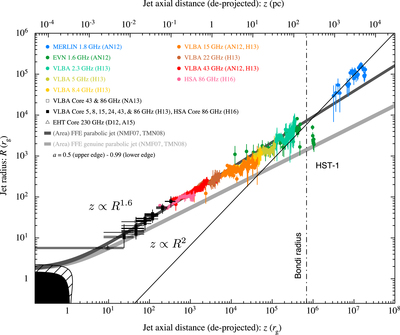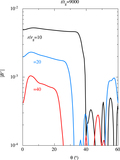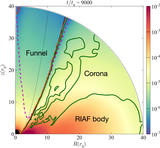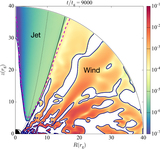Image Details

Caption: Figure 15.
Distribution of the jet radius R as a function of the jet axial distance z (deprojected with M = 6.2 × 109 M⊙ and θv = 14°) from the SMBH in units of rg (see Asada & Nakamura 2012; Hada et al. 2013; Nakamura & Asada 2013, labeled as AN12, H13, and NA13, respectively). Additional data points are taken from Doeleman et al. (2012), Akiyama et al. (2015), and Hada et al. (2016) (labeled as D12, A15, and H16, respectively). The (vertical) dot-dashed line denotes the Bondi radius rB, located at ≃6.9 × 105rg, and the HST-1 complex is around 106rg. The filled black region denotes the BH (inside the event horizon), while the hatched area represents the ergosphere for the spin parameter a = 0.99. The light-gray area denotes the approximate solution (e.g., NMF07; TMN08) of the FFE genuine parabolic jet (outermost BZ77-type streamline: ﹩z\propto {R}^{2}﹩ at R/rg ≫ 1), while the dark-gray area is the case of the parabolic jet (outermost BP82-type streamline: z ∝ R1.6 at R/rg ≫ 1). In both of the outermost streamlines, which are anchored to the event horizon with θfp = π/2, a variation from a = 0.5 (upper edge) to a = 0.99 (lower edge) is represented as a shaded area. The solid line is the linear least-square for data points of MERLIN 1.8 GHz, indicating the conical stream z ∝ R (Asada & Nakamura 2012).
Copyright and Terms & Conditions
© 2018. The American Astronomical Society. All rights reserved.












